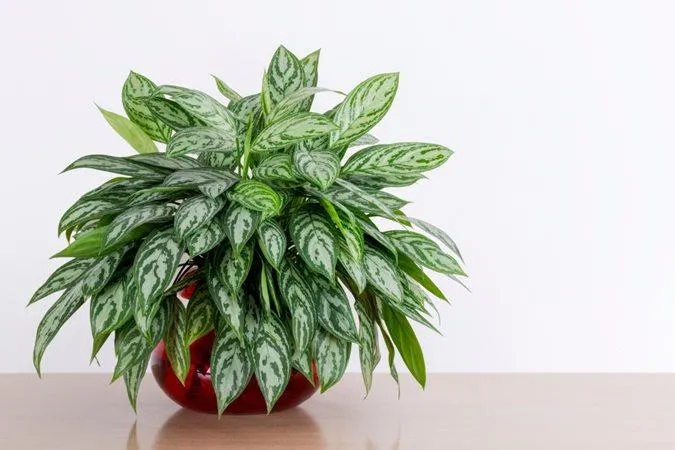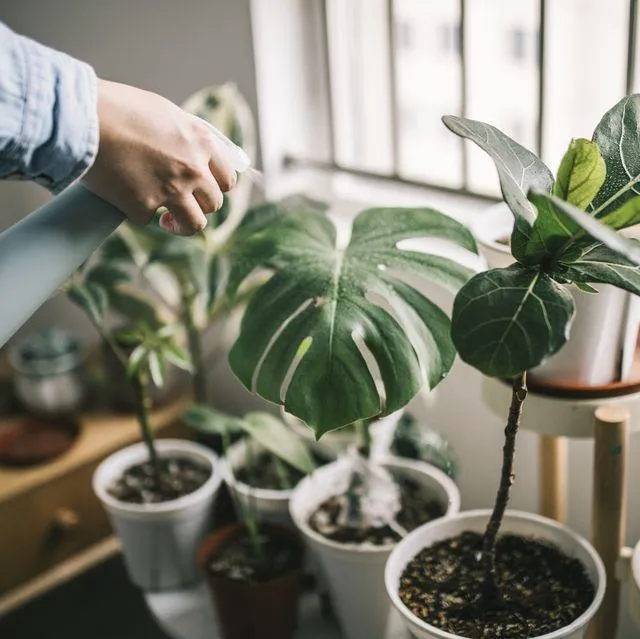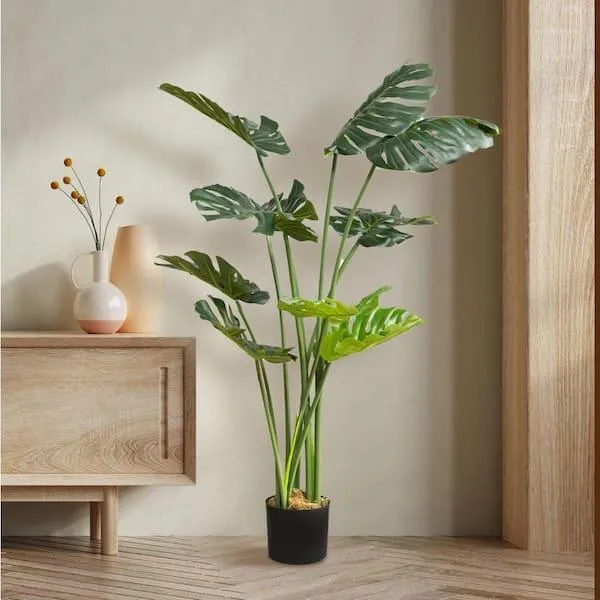Top Choices for Leafy Decorative Houseplants
If you’re looking to add some greenery to brighten up your home, leafy decorative plants are a great option. In this article, I’ll go over some of the best varieties to consider and provide care tips to keep them looking their best. Whether you’re a plant newbie or experienced green thumb, there should be something here to suit your needs.
Chinese Evergreens
Chinese evergreens (Aglaonema species) are tough, hardy plants that thrive in low-light conditions. Their variegated heart-shaped or oblong leaves come in a variety of bright colors like pink, red, and green. According to my experience, these plants are fairly low maintenance and tolerant of neglect. They don’t need dire t sunlight and prefer medium to dry soil. Chinese evergreens can last for months without watering!
An ‘Ascot Rainbow’ Chinese evergreen makes a beautiful statement piece with its pink, cream, and green leaves. I also like ‘Maria’ varieties – their dark maroon foliage really pops against a window. These plants make kind of awesome office decor since they’re so resilient despite poor conditions. Just water when the soil is dry and wipe down the leaves occasionally.
Peace Lilies
Peace lilies (Spathiphyllum) are among the best indoor air-purifying plants according to studies. Their large, glossy leaves emerge in an upright mound shape. What’s amazing is that these plants actually bloom white flowers, too! For lush growth, I suggest keeping peace lilies in medium to low light and watering only when the top inch of soil dries out. They can handle infrequent watering better than most leafy plants.
My favorite variety is ‘Select Spathiphyllum’ due to its abundant dark green leaves that really frame the white blooms. Peace lilies definitely reduce stress in living areas and can endure fluorescent lighting at the office. Just don’t fertilize often to avoid yellow leaf tips.

Spider Plants
Spider plants (Chlorophytum comosum) have long, grass-like leaves and produce miniature plantlets called ‘pups’ on their flower stems. They come in solid green or variegated patterns for a unique look. These guys adapt well to almost any light area – they’ll tolerate direct sun but also do fine in low-light conditions. A real bonus is that spider plants are non-toxic for furry friends and kids.
propagating new plants is super simple too – once those pups develop roots you can pop them out and start a whole new spider plant colony! In my experience, they’re low fuss and forgiving of occasional dry soil. Just water when top inch is dry. Spider plants truly brighten up any space with their bold leaves and spreading habit.
Philodendron
Philodendron varieties offer an amazing variety of leaf shapes and textures to suit different decor styles. Heart leaf philodendrons (Philodendron hederaceum) have deeply lobed, velvety green leaves perfect for hanging baskets or trailing down shelves. For a more modern look, try red or lime green velvet leaf varieties. These plants flourish in medium to low indirect light and average indoor temperatures.
According to my experience, philodendrons tend to be climbing vines so give them a moss pole or trellis for support. Their foliage comes in every shade of green plus splashes of cream, pink, and red. Be sure not to overwater and only water when top inch of soil is dry. Propagating new plants from stem or leaf cuttings is basically easy as pie with philodendrons too!
Snake Plants
Snake plants (Sansevieria species) basically don’t require much care at all! Their stiff, upright leaves come in solid colors like dark green or variegated yellow and white patterns. These succulent-like plants can endure intense sunlight near south windows or very low indirect light. From my experience, they thrive on infrequent watering – like once every 2-4 weeks. Snake plants are seriously resilient to neglect.

The ‘Laurentii’ variety has thick gray-green leaves perfect for modern decor while ‘Golden Hahnii’ boasts bold yellow variegation. These plants add architectural interest without high maintenance. Snake plants purify indoor air, too! Just check soil moisture before watering and wipe down leaves occasionally. Their straight vertical form makes snake plants versatile for any space.
Dieffenbachia
For a bold tropical look, dieffenbachia (Dumb Cane) plants boast large, lush leaves in shades of green with cream or yellow variegation. I warn plant parents to handle these guys carefully though – their sap can cause a tingling sensation on skin. Dieffenbachias benefit from medium to low indirect light like east or north-facing windows. According to my experience, their thick leaves make for an air of drama.
‘Tropic Snow’ has creamy white variegation while ‘Camille’ dazzles with wide green leaves edged in yellow. These plants shouldn’t be near pets due to potential toxicity if chewed. Water dieffenbachias when top inch of soil is dry and groom away yellow leaves as needed. Overall they flourish with minimal care despite the mild warning.
Other Considerations for Leafy Houseplants
Whether you’re looking sort of furnish living spaces or add vibrant plant life to an office workplace, leafy varieties provide big impact with minimal fuss. Here are some extra tips I’ve learned over time:
- Start with hardy, forgiving plants suited to your light conditions before graduating to finicky ones.
- Check soil moisture by sticking your finger in instead of going by a schedule – all plants dry out at somewhat different rates.
- Use a pebble tray under pots to increase humidity for tropical varieties. Water pebbles, not soil, for humidity around whole plant.
- Wipe down leaves occasionally with a damp cloth to remove dust – they’ll stay healthier and photosynthesize better that way.
- Rotate plant pots weekly so all sides receive indirect light evenly to prevent lopsided growth.
- Repot only when roots fill the container – going up one size at most every year or two keeps roots happy.
Hopefully this overview on top leafy houseplants provided answers to all your questions on care needs and varieties suited as living decor. Investing in healthy, thriving indoor greenery is kind of like a mood-boost each time you come home or walk into your work area. So find some leafy beauties calling to you and get planting!

Let me know if any other questions come up on keeping your new plant pals happy and green. Wishing you the best in nurturing your indoor jungle – feel free to reach out if issues arise down the road. Happy planting!
Top Leafy Decorative Houseplants
| Plant | Water Needs | Sunlight | Height | Care Level |
|---|---|---|---|---|
| Peace Lily | Moderate | Low to Bright Indirect | 2-3 feet | Easy |
| Pothos | Let dry between waterings | Low to Bright Indirect | Up to 10 feet | Very Easy |
| Chinese Evergreen | Let dry slightly between waterings | Low to Medium | 3-6 feet | Easy |
| Spider Plant | Let dry slightly between waterings | Low to Bright Indirect | 2-3 feet | Very Easy |
| ZZ Plant | Let dry completely between waterings | Low to Bright Indirect | 2-6 feet | Very Easy |
FAQ
-
What types of leafy decorative plants are common?
Basically, there are several kinds of leafy green plants which people use for decorating their homes. Some popular choices include plants like peace lilies, Chinese evergreens, English ivy, spider plants, and pothos. These leafy plants don’t need much light or water to thrive. At the same time, they look gorgeous and add some lush greenery to any room.
-
How often do I need to water leafy plants?
Most leafy plants need water whenever the top inch or two of soil becomes dry. To check moisture levels, you can stick your finger in the dirt. If it feels damp below, no water is necessary yet. However, during hotter months or if the plant is in direct sun, additional water may be required perhaps every five days or so. Nevertheless, it’s better not to overwater leafy plants as this can cause root rot. The secret is finding the right moisture balance for each plant type.
-
Do leafy plants need fertilizer?
Maybe not all the time. Leafy plants can go for months without fertilizer as long as their potting mix contains some nutrients. However, applying a diluted liquid houseplant fertilizer during the growing season from spring to fall seems to make plants healthier and boost their leaf growth. On the other hand, it’s important not to fertilize when plants are dormant in winter as this could damage them. You don’t want to “overfeed” leafy plants either. Perhaps following the package instructions is the safest approach.
-
How do I get rid of pests on my leafy plants?
Pests like spider mites, aphids and scale insects can sometimes plague leafy plants. If a small infestation appears, you may be able to rinse the pests away using a gentle spray of water. For a more serious bug problem, experts suggest treating with neem oil or insecticidal soap, both of which are natural pest controls. Repeated applications at weekly intervals should banish most pests. Is that fair? Make sure to isolate any infested plants, as pests can spread quickly between houseplants. Staying vigilant is key to keeping leafy plants bug-free.

-
What is the best organic way to prune leafy plants?
To keep leafy plants looking their best and encourage new growth, pruning is important but must be done carefully. Basically, just pinch or cut off any damaged, diseased or dead pieces with sterilized pruners. Regular light pruning also shape the plant and maintains a bushier appearance. Perhaps the most organic method involves using rubbing alcohol to disinfect pruners between cuts. This kills any potential bugs or diseases. You can also substitute the alcohol for a 10% hydrogen peroxide solution for pruning. Either way, pruning tools must stay clean to prevent spreading issues to other plants. Sound advice, right?
-
What can go wrong with leafy decorative plants?
While leafy plants are fairly low maintenance, a number of problems can potentially impact them. For example, overwatering is awful and leads to root rot. Underwatering causes brown leaf tips and edges. Too much intense sun will scorch leaves. Insufficient light produces spindly growth. Drafts and vents can dry leaves. Then there are the dreaded pests like spider mites and scale. Organisms in poor potting soil mix commonly cause issues as well. The stunning spider plant in my office is a classic example – its base is constantly crawling with fungus gnats! Any signs of these issues means it’s time to take corrective action asap to save leafy plants. Memories of plant hospital visits always bring back gut-wrenching associations!
-
Are some leafy houseplants safer for kids and pets?
When decorating homes with leafy greenery, it’s smart to consider safety around children and furry friends. Botanist Zach Schwalm notes that many popular houseplants pose no risk, like Chinese evergreens, pothos ivy, peace lilies and snake plants. Their leaves are not tempting morsels. However, some varieties contain calicins that can cause tummy troubles if nibbled, like English ivy and philodendrons. So those leafy plants may be better displayed higher up or out of reach. Does this help address any safety worries? The choice ultimately depends on your unique household situation. Let me know if you have additional questions!
